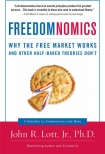Freedomnomics: Why the Free Market Works and Other Half-Baked Theories Don't John Jr. (the dot read aloud .txt) 📖

- Author: John Jr.
Book online «Freedomnomics: Why the Free Market Works and Other Half-Baked Theories Don't John Jr. (the dot read aloud .txt) 📖». Author John Jr.
What happens to these babies of reluctant fathers? The mothers often end up raising the child on their own, as single mothers have become much less likely to give their children up for adoption. Even as out-of-wedlock births have surged, adoption rates have plummeted. In the two decades before Roe, 19.3 percent of babies born to unwed white mothers were placed for adoption and 1.5 percent for unwed black mothers. From 1973 to 1981, those percentages fell to 7.6 and 0.2 percent, respectively, and continued to decline thereafter.32 How can we explain this? As stated above, after Roe, a rising number of out-of-wedlock children were born to women who opposed abortion, or at least would not have one themselves. These women have also proved less willing to give up their children for adoption.
With work and other demands on their time, single parents, no matter how “wanted” their child may be, tend to devote less attention to their children than do married couples; after all, it’s difficult for one person to spend as much time with a child as two people can. Grand-parents and other relatives may sometimes help out, but on average, the children of single parents still receive less care.
The children of unmarried, cohabitating couples also receive less care and attention than married couples’ children. This is partly because cohabiting partners face much higher separation rates than married couples do.33 Many cohabitating couples are not married because they are not yet ready to make a lifetime commitment to each other. And if partners believe their relationship may not be permanent, they are less likely to make career adjustments or other sacrifices for the sake of their family. Thus, single parents and unmarried couples are less likely than married parents to read to their children or take them on excursions, and more likely to feel angry at their children or feel that their children are burdensome. Children raised outside of wedlock experience a higher rate of social problems in nearly every area than children of married couples. Unsurprisingly, children from unmarried families are also more likely to grow up to commit crimes.34
Percentage of Children with Different Types of Problems by Marital Status of Parents35
So the opposing arguments are clear—one stresses that abortion eliminates “unwanted” children, while the other emphasizes that abortion increases out-of-wedlock births. Both effects, conceivably, could be occurring at the same time. The question is: which one has the bigger impact on crime?
This must be answered empirically. Unfortunately for advocates of the “abortion decreases crime” theory, Donahue and Levitt’s data were undermined by methodological flaws. As The Economist magazine noted in an article entitled “Oops-onomics,” “Donohue and Levitt did not run the test that they thought they had.”36 Work by two economists at the Boston Federal Reserve, Christopher Foote and Christopher Goetz, found that when the tests were run correctly, they indicated that abortion actually increases violent crime.37 I co-authored a study with John Whitley that found a similar connection between abortion and murder—namely, that legalizing abortion raised the murder rate, on average, by about 7 percent.38
We find particularly troublesome problems with the “abortion decreases crime” theory when we analyze the population according to age group. Suppose that liberalizing abortion in the early 1970s can indeed explain up to 80 percent of the drop in murder during the 1990s, as Donohue and Levitt claim. Then the impact of deregulating abortion, undoubtedly, would first reduce criminality among age groups born after the abortion law was changed, when the “unwanted,” crime-prone elements of these groups began to be weeded out through abortion. Yet, looking at the declining murder rate during the 1990s, Whitley and I found that this is not the case at all. Instead, the rate of committing murder began falling first among an older generation—those twenty-six and older—who were born before the Roe v. Wade decision.39 It was only later that criminality among those born after Roe began to decline as well.
Comparing the Rate of Murders Committed by Those Born in the Four Years Before and After Roe v. Wade for the 45 States and the District of Columbia Affected by the Ruling
This pattern is more consistent with the theory that legalizing abortion led to a rise in crime. In fact, those born in the four years after Roe were much more likely to commit murder than those born in the four years prior to Roe. This was especially the case when they were in their teens—in other words, in their “criminal prime.”
And that’s not all. The “abortion decreases crime” argument encounters further inconsistencies when we compare U.S. crime and abortion trends to those in Canada. While crime rates in both the United States and Canada began declining at the same time, Canada liberalized its abortion laws much later than the U.S. did. Although the province of Quebec effectively legalized abortion in late 1976, it wasn’t until 1988, in a case originating in Ontario, that the Canadian Supreme Court struck down limits on abortion nationwide.40 If the legalization of abortion in the U.S. caused crime to begin dropping eighteen years later, why did the crime rate begin falling just three years after the comparable legal change in Canada?
In sum, even if one effect of abortion were to lower crime by culling out “unwanted” children—a conclusion derived from flawed statistics—the effect is greatly outweighed by the rise in crime that abortion causes by increasing out-of-wedlock births. It should be noted that African Americans are disproportionately harmed by the crime stemming from legalized abortion. That population has seen the biggest increases in abortion, premarital sex, and out-of-wedlock birth rates, resulting in more African Americans being raised by single parents and eventually committing





Comments (0)